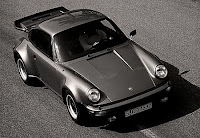 Porsche and Ferrari are German and Italian sides of the same
Porsche and Ferrari are German and Italian sides of the samecoin, interpretations of the sports car idea. Both founded by a
dominant patriarch, both honed in racing, both more than 50
years old, both with engineering and styling integrity. Whether on
the track of Le Mains or on the streets, the two have always been
put head-to-head and compared. Even the most naive motorist
associates these two names with both performance and style.
We’ve decided to compare the methodical Porsche 911 Carrera
4S and the passionate Ferrari F430 because both of them astonish
with their performance while attempting to maintain a reasonable
amount of practicality but do not pretend to be anything other than
sports cars.
A modern sports car should feature these characteristics: it should be
started easily, maneuvered around town, blasted on a couple of
country roads, it looks and performs the part on a racetrack but at the
same time it is very safe.
The easier way to separate the two cars is by measuring figures since
both of them have mastered the modern sports car requirements and
basically there’s no other way to choose between these two phenomenal
cars.
What initially impresses is Ferrari's lightning fast 4-second 0-100km/h
acceleration and thrilling exhaust tone. As the occupants are pinned to
the seats, the new generation 4.3-litre V8 pushes out 368 snarling
kilowatts. Porsche’s acceleration also offers that kick in the pants a
super car should deliver, although it is 0.8 seconds slower at the 100 km/k
mark.
With such acceleration performance, it comes natural for both cars to
excel in the braking department. The two cars offer optional ceramic
discs for impressive stopping.
Porsche’s engine gets the upper hand as it is more refined and on
the economy rank leaps ahead Ferrari with a 11.8 liters per 100 km
as opposed to 18.3 liters. Both cars deliver the power through impressive
6-speed gearboxes and offer top rate handling performance.
Both F430 and Carrera4S offer great interior comfort and even if the
space is limited, the occupants don't feel claustrophobic and flustered.
Although an impressive mix of suede, carbon fiber and aluminum abound
in the Ferrari, the Italians stand no chance when it comes to the high finish
level attained by the Germans.
Speed and silence are key elements for any super car. The look and
appearance is the biggest draw card. The Carrera 4S is a typical Porsche,
despite the new proportions. It is a great looking car, like any other 911 but
somehow the styling no longer creates the jaw dropping reaction that the
Ferrari does. Indeed, traditionalists may say that Porsche pays homage to
its roots, but the truth is that Ferrari F430 simply draws the attention.
However, even if Ferrari F430 takes your breath away with its appearance,
the super car title goes to the Porsche Carrera 4S with a more complete all
round package.














